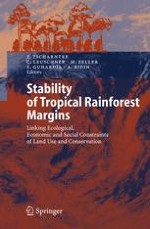2007 | Buch
Stability of Tropical Rainforest Margins
Linking Ecological, Economic and Social Constraints of Land Use and Conservation
herausgegeben von: Prof. Dr. Teja Tscharntke, Prof. Dr. Christoph Leuschner, Prof. Dr. Manfred Zeller, Prof. Dr. Edi Guhardja, Dr. Arifuddin Bidin
Verlag: Springer Berlin Heidelberg
Buchreihe : Environmental Science and Engineering
